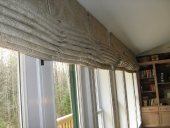My question is regarding lath houses and their ability to trap passive
solar radiant heat inside the structure.
We’re working on establishing a
permaculture education center in Eastern China and are retrofitting a northeastern style house and courtyard accompanying the
land. At the southern side of the house, a polytunnel originally connected the kitchen with the toilet, but it collapsed several times under light snow fall and hasn't been rebuilt in several years.
A large hill blocks out winter afternoon sun, but the
greenhouse apparently had decent heat gain throughout the winter when it was up, supporting a few tropical perennials. I’ve been in many polytunnels here throughout the winter months and they frequently reach summer temperatures as the coldest days are usually the sunniest.
The polytunnel isn’t something I’m interested in, creating a lot of plastic waste, requiring frequent maintenance and adjustments for airflow and temperature control, etc etc. I want the microclimate to be self maintaining at about +5 degrees in the winter and to provide substantial shading under the very hot direct subtropical sun throughout the summer.
I’m thinking to build a bamboo lath house with a few square meters of PMMA directly facing the late December 11am sun, hopefully allowing a substantial amount of
solar gain throughout the typically sunny winter months. Thermal mass would be oversized raised beds which would filter gray
water from the kitchen and
shower, along with several rain barrels, a few boulders and a small
pond.
The question is, will the lath house, with bamboo slats covering perhaps half the surface area, be able to keep in
enough radiant heat to keep temperatures a few degrees above the ambient temp throughout the day and into the night? The area isn’t particularly windy so I imagine this could provide at least some protection, I remember I’ve heard lath houses stave off frosts by having the cold air slide down around the structure rather than entering directly inside. I’m also not sure how this would work with the summer heat, but I would plan on growing a few vine crops on
trellis over the PMMA. Has anyone seen or heard of passive solar lath houses before?
Thanks for your time!
Thomas







